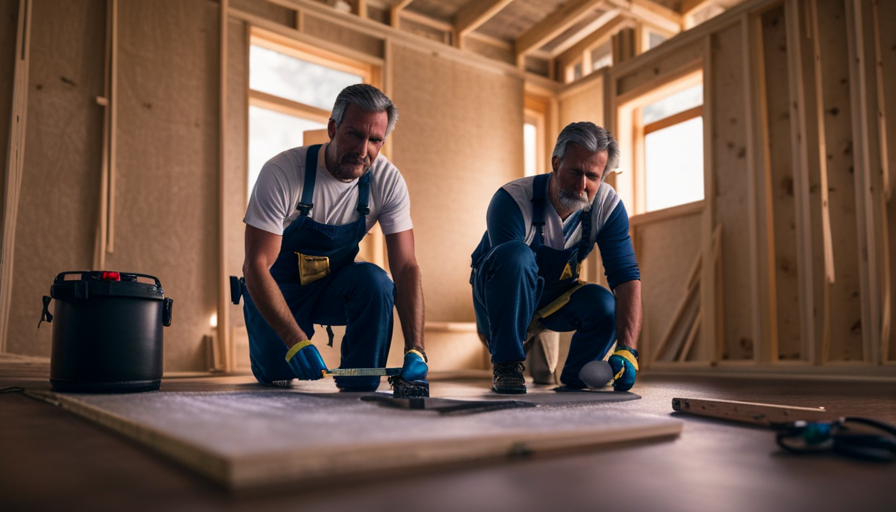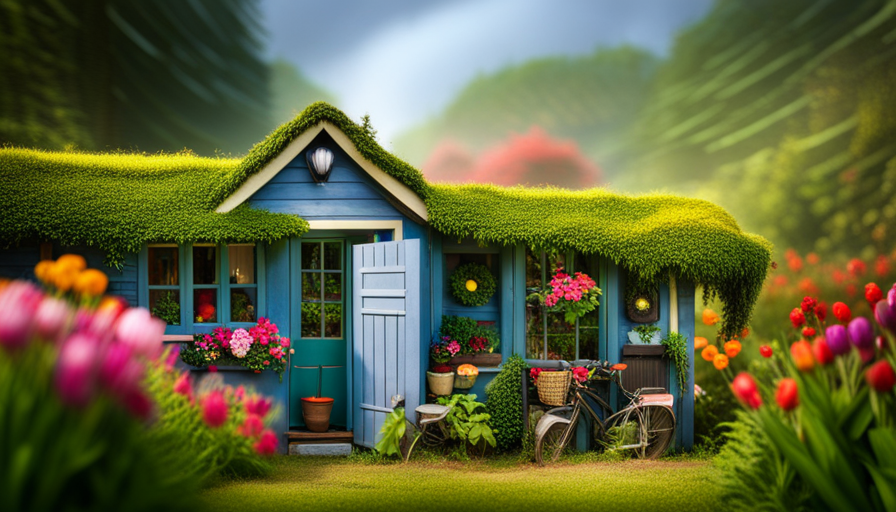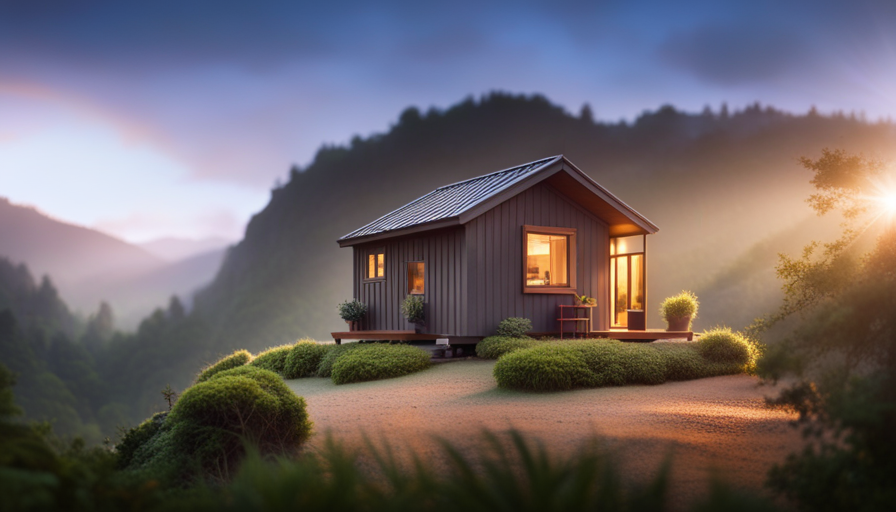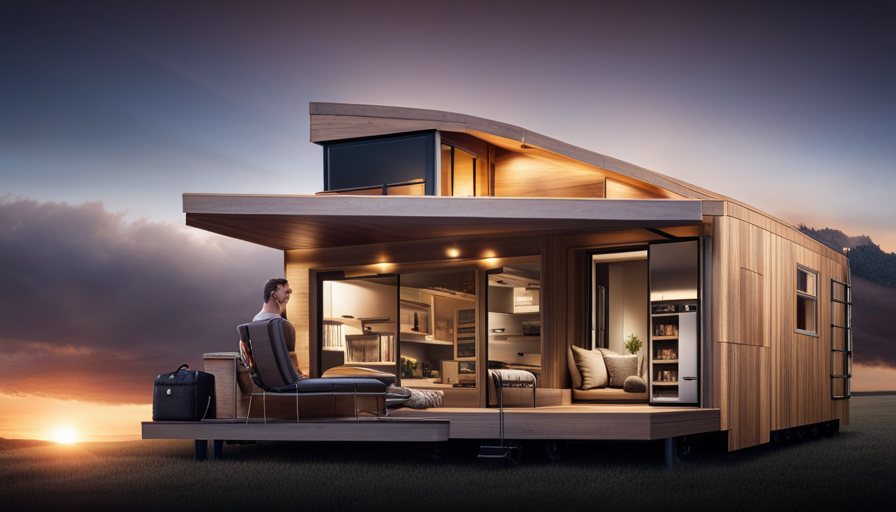Are you prepared to take on the challenge of insulating your small house? Don’t fret! This article will walk you through the steps of insulating your modest home, helping you to achieve a warm and energy-efficient living area.
Insulating a tiny house is a crucial step in maintaining comfortable temperatures and reducing energy consumption. By properly insulating your walls, ceilings, windows, and doors, you can protect your home from the ever-changing weather conditions.
To start, we will assess your insulation needs and select the perfect materials for the job. Then, we’ll craft a meticulous insulation strategy and prepare your tiny house for the installation process.
With careful precision, we will tackle the walls and ceilings, ensuring no nook or cranny is left uninsulated.
But we won’t stop there! We’ll also delve into insulating windows and doors, exploring additional strategies to maximize energy efficiency.
Finally, we’ll test and evaluate our insulation, providing tips on maintenance and updates to keep your tiny house snug and warm.
So, let’s embark on this insulation adventure together and create the perfect sanctuary for you to call home!
Key Takeaways
- Assess current insulation performance and identify areas for improvement.
- Consider insulation cost comparison to determine the most cost-effective solution.
- Choose the right insulation materials based on factors like cost, R-value, and ease of installation.
- Properly seal gaps and cracks, inspect windows and doors for drafts, and remove ineffective insulation before installing new insulation.
Assess Your Insulation Needs
Assessing your insulation needs is like taking a snapshot of your tiny house’s temperature control. It helps you determine how efficient your current insulation is and identify areas for improvement.
Start by assessing insulation efficiency, which involves evaluating how well your current insulation is performing in terms of maintaining a comfortable indoor temperature and reducing energy consumption. This can be done by checking for drafts, cold spots, and high energy bills.
Additionally, consider insulation cost comparison to determine the most cost-effective solution for your tiny house. Compare the initial cost, long-term savings, and lifespan of different insulation materials.
Once you have assessed your insulation needs and identified areas for improvement, you can move on to choosing the right insulation materials that will help maximize energy efficiency and create a comfortable living environment.
Choose the Right Insulation Materials
When it comes to keeping your cozy abode warm, selecting the perfect materials for insulation is a crucial step in creating a snug and energy-efficient living space. Choosing the right insulation materials is essential for maximizing energy efficiency and maintaining a comfortable temperature inside your tiny house.
There are various options available, such as fiberglass batts, spray foam, rigid foam boards, and cellulose insulation. Each material has its own unique properties and benefits, so it’s important to consider factors like cost, R-value, and ease of installation.
Fiberglass batts are affordable and easy to install, while spray foam provides excellent air sealing and insulation. Rigid foam boards offer high R-values, and cellulose insulation is eco-friendly.
By selecting the appropriate insulation materials based on your budget and needs, you can ensure that your tiny house remains cozy and energy-efficient. Now, let’s move on to planning your insulation strategy.
Plan Your Insulation Strategy
To effectively create a snug and energy-efficient living space, it’s crucial to carefully plan out your insulation strategy. One key aspect to consider is the cost of insulation. Different materials come at varying prices, so it’s essential to find a balance between affordability and effectiveness.
Take into account the long-term energy savings that high-quality insulation can provide. Additionally, consider the insulation techniques that will work best for your tiny house. Whether it’s using batts, spray foam, or rigid foam boards, each option has its benefits and drawbacks. Understanding the pros and cons of each technique will help you make an informed decision.
By carefully considering the insulation cost and techniques, you can ensure that your tiny house is properly insulated for maximum comfort and energy efficiency.
Now, let’s move on to how to prep your tiny house for insulation.
Prep Your Tiny House for Insulation
Before starting the insulation process, it’s important to ensure that your tiny home is properly sealed. A study found that air leaks can account for up to 40% of energy loss in a house. To prep your tiny house for insulation, here are some helpful tips:
- Check for any gaps or cracks in the walls, ceilings, and floors, and seal them with caulk or weatherstripping.
- Inspect the windows and doors for any drafts, and consider adding weatherstripping or installing insulated curtains.
- Remove any existing insulation that may be damaged or ineffective, and clean the surfaces to create a smooth and even base for the new insulation.
When your tiny house is properly sealed and prepped, you can move on to the next step of installing insulation in the walls and ceilings.
Install Insulation in Walls and Ceilings
When it comes to installing insulation in the walls and ceilings of my tiny house, I always make sure to use proper installation techniques. This ensures that the insulation is effective in keeping my home warm in the winter and cool in the summer.
Additionally, I consider different insulation types for various areas of my tiny house. For example, I use spray foam insulation for hard-to-reach spaces and batt insulation for walls and ceilings.
By following these practices, I can create a well-insulated and comfortable living space in my tiny house.
Use Proper Installation Techniques
Make sure you’re using proper insulation techniques to effectively insulate your tiny house. Proper installation techniques are crucial in achieving optimal insulation performance. Here are some key techniques to consider:
| Technique | Description | Benefits |
|---|---|---|
| Air sealing | Seal all gaps and cracks to prevent air leakage, improving energy efficiency and thermal comfort. | Reduces drafts and heat loss. |
| Vapor barrier | Install a vapor barrier to prevent moisture buildup, protecting your tiny house from damage. | Prevents mold and mildew growth. |
| Proper compression | Ensure insulation is compressed just enough to fill the space without causing air gaps. | Maximizes thermal efficiency. |
By employing these proper installation techniques, you can enhance the insulation performance of your tiny house. However, it’s also crucial to consider different insulation types for various areas. This will be discussed further in the subsequent section.
Consider Different Insulation Types for Various Areas
It’s essential to explore different insulation types for different areas to ensure maximum comfort and energy efficiency in your cozy sanctuary.
When it comes to insulating the roof of your tiny house, consider options like spray foam insulation or rigid foam boards. These types of insulation provide excellent thermal resistance and can effectively seal any gaps or cracks.
For the floors, you have a few choices. One option is to use fiberglass batts, which are easy to install and provide good insulation. Another option is to use rigid foam insulation boards, which offer high thermal resistance and can help reduce noise transmission.
When insulating the floors, it’s crucial to consider the specific needs and requirements of your tiny house.
By carefully selecting the right insulation types for both the roof and the floors, you can create a well-insulated and comfortable living space.
Insulate the Floors
To ensure maximum comfort and energy efficiency, one must insulate the floors of a tiny house. Insulating the floors not only helps to regulate the temperature inside the house, but it also provides a barrier against moisture and sound. There are several benefits of floor insulation, including improved thermal performance, reduced energy costs, and enhanced acoustic insulation.
To further understand the advantages of insulating the floors, let’s take a look at the following table:
| Benefits of Floor Insulation |
|---|
| Increased energy efficiency |
| Improved temperature control |
| Enhanced soundproofing |
By insulating the floors, you can significantly reduce heat loss and prevent drafts, resulting in lower heating bills. Additionally, a well-insulated floor helps maintain a comfortable temperature throughout the year. It also acts as a sound barrier, reducing noise transmission from the outside or between different areas within the tiny house.
Now, let’s move on to the next section and discuss how to insulate windows and doors effectively.
Insulate Windows and Doors
Ensure maximum comfort and energy efficiency in your tiny home by effectively insulating the windows and doors, creating a cozy and peaceful living space.
To insulate windows, consider using weatherstripping or caulking to seal any gaps or cracks around the frames. Adding window film or thermal curtains can also help to reduce heat loss.
For the doors, install door sweeps to seal the bottom and weatherstripping around the edges. Additionally, use draft stoppers or door snakes to further prevent drafts.
Remember to insulate the glass panes by applying window insulation film or using thermal blinds.
By insulating the windows and doors, you can significantly decrease heat loss and minimize air infiltration, leading to lower energy bills and a more comfortable living environment.
Consider additional insulation strategies to further enhance the energy efficiency of your tiny home.
Consider Additional Insulation Strategies
Consider implementing additional insulation strategies in order to maximize energy efficiency and create a more comfortable living environment in your compact dwelling. There are several additional insulation options that can be considered to further improve the insulation of your tiny house. These options include insulating the floor, ceiling, and walls with materials such as foam board insulation or spray foam. Adding insulation to these areas can significantly reduce heat loss and gain, resulting in lower energy bills and increased comfort. Additionally, using insulated curtains or blinds can help to further insulate windows and minimize heat transfer. By incorporating these additional insulation strategies, you can enhance the energy efficiency benefits of your tiny house and create a cozy living space. In the next section, we will discuss how to test and evaluate the effectiveness of your insulation.
Test and Evaluate Your Insulation
Evaluate the effectiveness of your insulation by conducting tests and measurements to determine if your compact dwelling is truly a cozy oasis. To accurately assess the performance of your insulation, consider the following:
-
Thermal imaging: Use a thermal camera to identify any areas where heat is escaping or cold air is seeping in. This will help you pinpoint any weak spots in your insulation system.
-
Blower door test: Conduct a blower door test to measure the air leakage in your tiny house. This will help you gauge the effectiveness of your insulation in preventing drafts and maintaining a comfortable indoor environment.
-
R-value comparison: Compare the R-values of different insulation materials to determine which option provides the best thermal resistance for your specific needs.
-
Energy consumption monitoring: Track your energy usage to see if your insulation is helping to reduce heating and cooling costs.
By evaluating the effectiveness of your insulation and comparing different options, you can ensure that your tiny house remains energy-efficient and comfortable.
Moving on to maintaining and updating your insulation, it’s important to regularly check for any wear and tear that may compromise its performance.
Maintain and Update Your Insulation
To keep your insulation in top shape and guarantee a cozy and energy-efficient living environment, it’s crucial that you regularly inspect and update it. Over time, insulation can become worn or damaged, reducing its effectiveness. By staying proactive and maintaining your insulation, you can ensure that it continues to provide the desired level of thermal protection.
There are several update techniques you can employ to maximize the efficiency of your insulation. One option is to add additional layers of insulation to areas that may be lacking. This can be done by using batt insulation or blown-in insulation. Another alternative is to consider using eco-friendly insulation materials, such as cellulose or recycled denim, which offer excellent thermal performance and are more sustainable.
By regularly maintaining and updating your insulation, you can create a comfortable and energy-efficient living space in your tiny house. Don’t forget to inspect your insulation periodically and consider incorporating insulation alternatives to further enhance its performance.
Frequently Asked Questions
Can I use the same insulation material for both the walls and the ceilings?
Using different insulation materials for walls and ceilings can have its pros and cons. The benefit of using the same insulation material for both is that it simplifies the installation process and ensures consistent insulation throughout the tiny house. However, it may not be the most efficient solution as walls and ceilings have different insulation needs.
Walls require higher R-values for better heat retention, while ceilings need insulation that prevents heat from escaping. It’s important to consider these factors when deciding on insulation materials for your tiny house.
How do I insulate the windows and doors in my tiny house?
Insulating windows and doors in a tiny house is crucial for maintaining energy efficiency and comfort. To insulate windows, I recommend using weatherstripping to seal any gaps and installing thermal curtains or window film for extra insulation.
For doors, adding weatherstripping and using door sweeps can help prevent drafts. Additionally, using insulated or solid-core doors can further enhance insulation.
By properly insulating windows and doors, you can greatly improve the overall insulation of your tiny house.
Are there any additional insulation strategies that I should consider for my tiny house?
When it comes to insulating a tiny house, there are various insulation materials and alternative methods that you should consider. Some popular insulation materials include fiberglass, spray foam, and cellulose.
Additionally, you can explore alternative insulation methods such as using recycled denim or sheep’s wool. These materials provide excellent thermal insulation and are eco-friendly choices.
It’s important to research and choose the insulation materials and methods that best suit your tiny house’s needs and budget.
How do I test and evaluate the effectiveness of the insulation in my tiny house?
Testing methods are crucial to evaluate insulation effectiveness in a tiny house. To do so, I employ an allegorical approach akin to a detective investigating a case.
Using thermal imaging cameras, I scan the walls and ceilings to identify any heat leaks.
I also conduct blower door tests to measure air infiltration.
These methods provide precise data on the insulation’s performance, allowing me to make necessary adjustments and ensure my tiny house stays cozy and energy-efficient.
How often should I update or replace the insulation in my tiny house?
I should update or replace the insulation in my tiny house when it starts to show signs of wear and tear or when it no longer effectively insulates the space. The lifespan of insulation can vary depending on the type and quality, but generally, it’s recommended to inspect and maintain the insulation every few years.
Regular maintenance, such as checking for any damage or gaps, can help ensure optimal insulation performance and energy efficiency.
Conclusion
In conclusion, insulating a tiny house is crucial for maintaining comfort and energy efficiency. By assessing insulation needs, choosing the right materials, and planning a strategy, you can effectively insulate your tiny home.
Remember, "a stitch in time saves nine," so investing in proper insulation now will save you from future headaches and costly repairs.
Regularly testing, evaluating, and maintaining your insulation will ensure its effectiveness over time.
Keep your tiny house cozy and warm with these practical insulation tips.
Hi, I’m Emma. I’m the Editor in Chief of Tiny House 43, a blog all about tiny houses. While tree houses are often associated with childhood, they can be the perfect adult retreat. They offer a cozy space to relax and unwind, surrounded by nature. And since they’re typically built on stilts or raised platforms, they offer stunning views that traditional homes simply can’t match. If you’re looking for a unique and romantic getaway, a tree house tiny house might just be the perfect option.










